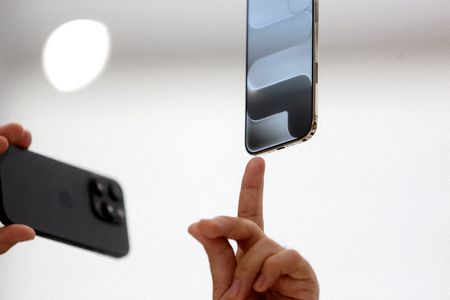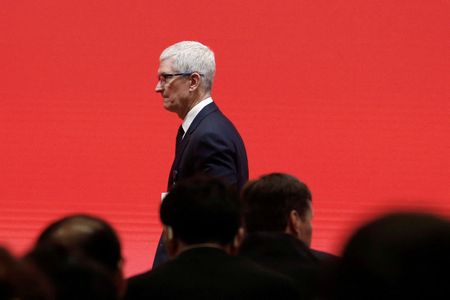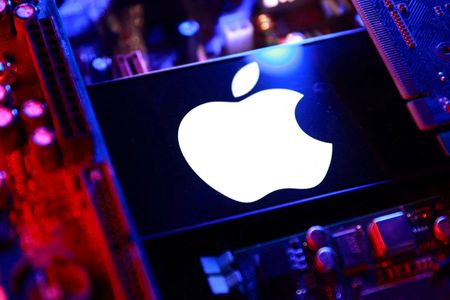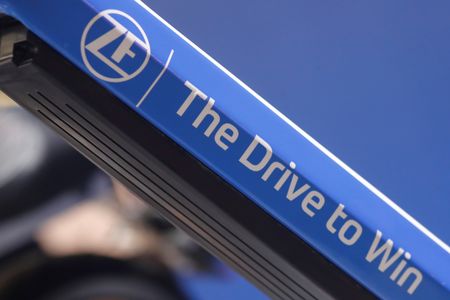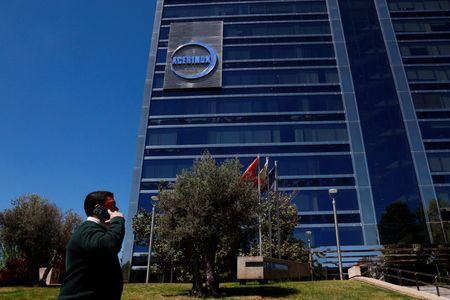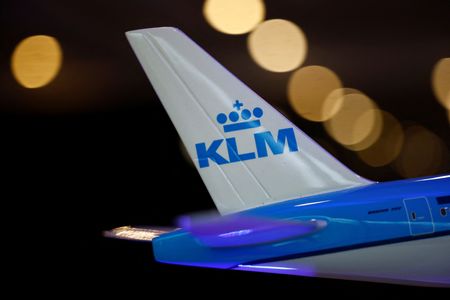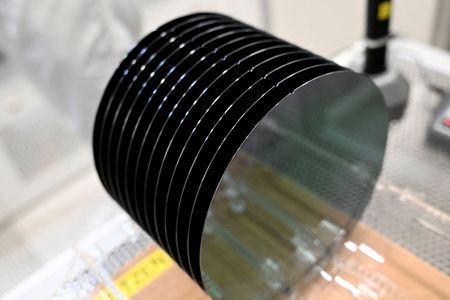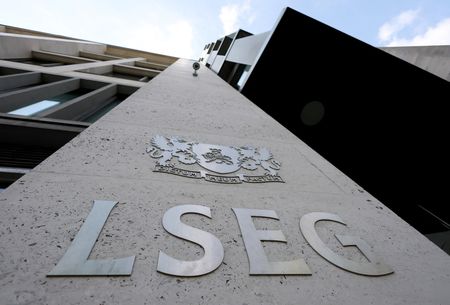By Stephen Nellis, Akash Sriram and Kenrick Cai
WASHINGTON (Reuters) -Apple Chief Executive Tim Cook on Thursday gave forecasts for holiday quarter iPhone sales and overall revenue that surpass Wall Street expectations, powered by orders for iPhone 17 models that the company is racing to fulfill amid continuing supply constraints.
The constraints, as well as delays in shipping new phones to China, led Apple to miss iPhone sales forecasts in the fiscal fourth quarter, although the shortfall was made up for by strength in other areas such as new AirPods that use AI to translate languages, and profit topped Wall Street targets.
Apple shares rose 3.7% in after-hours trading on Thursday.
The results showed that the biggest risks many investors saw to Apple’s business – its exposure to U.S.-China trade tensions and its lag in rolling out AI features – played a smaller role than the complexity of building and shipping hundreds of millions of devices.
In an interview with Reuters, Cook said he expects iPhone sales in the current, holiday-focused quarter to grow by double digits year over year and Apple’s overall revenue to grow 10-12% year over year. Those forecasts for Apple’s fiscal first quarter of 2026 beat analyst estimates of iPhone sales rising 9.8% to $75.91 billion and total sales up 6.6% to $132.53 billion, according to data from LSEG.
The outlook comes as Cook said the company struggled to meet demand for several iPhone 17 models and some older iPhone 16 models during its just-ended fiscal fourth quarter. The company also faced delays in China launching its iPhone Air model, the thinnest it has ever created and its biggest iPhone design overhaul in years.
Cook told Reuters that the China delay was the “primary reason” that sales contracted there during the fiscal fourth quarter.
“However, we’re very enthusiastic about China,” he said. “We love the response to the new products there, and we expect to grow or to return to growth in Q1.”
Cook said Apple is still working to resolve some of the supply constraints.
“Currently in Q1, we’re experiencing supply constraints still on several models of the iPhone 17, and we’re filling orders just as fast as we can,” Cook said. “It’s a good problem to have.”
Among the “Magnificent Seven” tech stocks, Apple’s share gains have trailed those of its rivals this year as investors wait to see whether it can catch up with artificial intelligence features. The company has said its biggest updates to Siri, its virtual assistant, will come next year, and Cook told Reuters that Apple is “making good progress” on those upgrades.
“The expectation of a strong holiday quarter gives Apple a runway to reaffirm demand, but it will be interesting to see how effectively it converts that momentum into a durable AI and infrastructure advantage,” said Natalie Hwang, founding managing partner of Apeira Capital.
Apple’s reliance on hardware sales has also left it with greater exposure to U.S. President Donald Trump’s trade war with China. Apple executives on Thursday reported tariff-related costs of $1.1 billion, in line with their forecast three months earlier. Chief Financial Officer Kevan Parekh said he expects $1.4 billion in tariff-related costs in the current quarter ending in December, which would put gross margins at 47-48%. Wall Street on average expects gross margins of 46.9%, according to LSEG data.
NEW IPHONES SHIPPING
Apple is hoping that its new iPhone Air – a possible precursor to a folding phone – along with more powerful iPhone Pro models and improved base iPhone models – will boost sales.
Apple’s fiscal fourth quarter is typically its slowest sales period as consumers wind down buying older iPhone models and await the launch of new ones. Apple’s new models began shipping to most markets on September 19, so the quarter includes only limited sales from the recently launched devices.
Sales and profit for the quarter ended September 27 were $102.47 billion and $1.85 per share, compared with analyst expectations of $102.26 billion and $1.77 per share, according to LSEG data. Sales of the Cupertino, California, company’s iPhone were $49.03 billion, compared with expectations of $50.19 billion, according to LSEG data.
“My expectation is that iPhone Air sales are likely weak, but iPhone base and Pro models are stronger than expectations,” said Ryuta Makino, research analyst at Gabelli Funds. Makino added that “Guidance (was) better than expectation. Ten to 12 percent growth is strong.”
However, the iPhone Air did not ship to China until October 22 because of regulatory delays due to its inclusion of only an e-SIM card for wireless connectivity. Apple said sales in its Greater China region were $14.49 billion, compared with analyst estimates of $16.24 billion, according to data from Visible Alpha.
Apple said sales in its services segment, which contains Apple TV and its movie business, were $28.75 billion, compared with estimates of $28.17 billion, according to LSEG data. Mac sales were $8.73 billion compared with estimates of $8.59 billion, and iPad sales were $6.95 billion, compared with estimates of $6.98 billion.
Sales in Apple’s accessories business, which contains AirPods and Apple Watch devices, were $9.01 billion, compared with estimates of $8.49 billion, according to LSEG data.
(Reporting by Stephen Nellis in Washington, Kenrick Cai in San Francisco and Akash Sriram in Bengaluru; Editing by Peter Henderson and Matthew Lewis)

